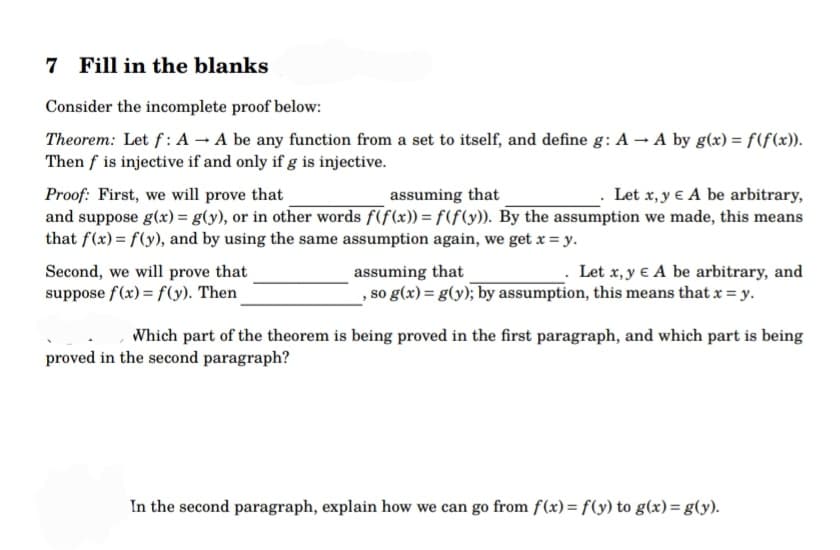7 Fill in the blanks Consider the incomplete proof below: Theorem: Let f: A→A be any function from a set to itself, and define g: A →A by g(x) = f(f(x)). Then f is injective if and only if g is injective. Proof: First, we will prove that assuming that Let x, y € A be arbitrary, and suppose g(x) = g(y), or in other words f(f(x)) = f(f(y)). By the assumption we made, this means that f(x) = f(y), and by using the same assumption again, we get x = y. Second, we will prove that suppose f(x) = f(y). Then assuming that , so g(x) = g(y); by assumption, this means that x = y. Let x, y € A be arbitrary, and Which part of the theorem is being proved in the first paragraph, and which part is being proved in the second paragraph? In the second paragraph, explain how we can go from f(x) = f(y) to g(x) = g(y).
7 Fill in the blanks Consider the incomplete proof below: Theorem: Let f: A→A be any function from a set to itself, and define g: A →A by g(x) = f(f(x)). Then f is injective if and only if g is injective. Proof: First, we will prove that assuming that Let x, y € A be arbitrary, and suppose g(x) = g(y), or in other words f(f(x)) = f(f(y)). By the assumption we made, this means that f(x) = f(y), and by using the same assumption again, we get x = y. Second, we will prove that suppose f(x) = f(y). Then assuming that , so g(x) = g(y); by assumption, this means that x = y. Let x, y € A be arbitrary, and Which part of the theorem is being proved in the first paragraph, and which part is being proved in the second paragraph? In the second paragraph, explain how we can go from f(x) = f(y) to g(x) = g(y).
Elements Of Modern Algebra
8th Edition
ISBN:9781285463230
Author:Gilbert, Linda, Jimmie
Publisher:Gilbert, Linda, Jimmie
Chapter1: Fundamentals
Section1.7: Relations
Problem 22E: A relation R on a nonempty set A is called asymmetric if, for x and y in A, xRy implies yRx. Which...
Related questions
Question

Transcribed Image Text:7 Fill in the blanks
Consider the incomplete proof below:
Theorem: Let f: A→A be any function from a set to itself, and define g: A →A by g(x) = f(f(x)).
Then f is injective if and only if g is injective.
Proof: First, we will prove that
assuming that
Let x, y € A be arbitrary,
and suppose g(x) = g(y), or in other words f(f(x)) = f(f(y)). By the assumption we made, this means
that f(x) = f(y), and by using the same assumption again, we get x = y.
Second, we will prove that
suppose f(x) = f(y). Then
assuming that
, so g(x) = g(y); by assumption, this means that x = y.
. Let x, y € A be arbitrary, and
Which part of the theorem is being proved in the first paragraph, and which part is being
proved in the second paragraph?
In the second paragraph, explain how we can go from f(x) = f(y) to g(x) = g(y).
Expert Solution
This question has been solved!
Explore an expertly crafted, step-by-step solution for a thorough understanding of key concepts.
Step by step
Solved in 2 steps with 2 images

Recommended textbooks for you

Elements Of Modern Algebra
Algebra
ISBN:
9781285463230
Author:
Gilbert, Linda, Jimmie
Publisher:
Cengage Learning,

Elementary Linear Algebra (MindTap Course List)
Algebra
ISBN:
9781305658004
Author:
Ron Larson
Publisher:
Cengage Learning

Algebra & Trigonometry with Analytic Geometry
Algebra
ISBN:
9781133382119
Author:
Swokowski
Publisher:
Cengage

Elements Of Modern Algebra
Algebra
ISBN:
9781285463230
Author:
Gilbert, Linda, Jimmie
Publisher:
Cengage Learning,

Elementary Linear Algebra (MindTap Course List)
Algebra
ISBN:
9781305658004
Author:
Ron Larson
Publisher:
Cengage Learning

Algebra & Trigonometry with Analytic Geometry
Algebra
ISBN:
9781133382119
Author:
Swokowski
Publisher:
Cengage